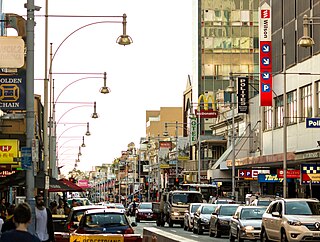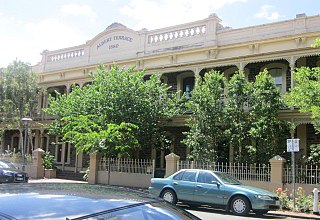
Rundle Mall is a pedestrian street mall located in Adelaide, South Australia. It was opened as a pedestrian mall in September 1976 by closing the section of Rundle Street between King William Street and Pulteney Street, to vehicular traffic. The street continues as Rundle Street to the east and Hindley Street to the west.

King William Street is the part of a major arterial road that traverses the CBD and centre of Adelaide, continuing as King William Road to the north of North Terrace and south of Greenhill Road; between South Terrace and Greenhill Road it is called Peacock Road. At approximately 40 metres (130 ft) wide, King William Street is the widest main street of all the Australian State capital cities. Named after King William IV in 1837, it is historically considered one of Adelaide's high streets, for its focal point of businesses, shops and other prominent establishments. The Glenelg tram line runs along the middle of the street through the city centre.

Hindley Street is located in the north-west quarter of the centre of Adelaide, the capital of South Australia. It runs between King William Street and West Terrace. The street was named after Charles Hindley, a British parliamentarian and social reformist.

Carrington Street is a street in the south-eastern sector of the centre of Adelaide, South Australia. It runs east–west, from East Terrace to King William Street, blocked at Hutt Street and crossing Pulteney Street at Hurtle Square. It is one of the narrow streets of the Adelaide grid, at 1 chain wide.

Sturt Street is a street in the south-western sector of the centre of Adelaide, South Australia. It runs east-west between West Terrace to King William Street, passing through Whitmore Square. After crossing King William Street, it continues as Halifax Street.

Wakefield Street is a main thoroughfare intersecting the centre of the South Australian capital, Adelaide, from east to west at its midpoint. It crosses Victoria Square in the centre of the city, which has a grid street plan. It continues as Wakefield Road on its eastern side, through the eastern Adelaide Park Lands.
J. Miller Anderson & Co. Limited was a drapery business in Adelaide, South Australia, Australia, generally known as Miller Anderson's, with origins dating back to the city's earliest days. The sign of the company was a golden lamb supported around the middle by a blue riband.

The Jubilee Exhibition Building in Adelaide, South Australia, was built to celebrate the 50th anniversary of Queen Victoria's accession to the throne on 20 June 1837. The jubilees of her Coronation on 28 June 1838, and of the Proclamation of South Australia on 28 December 1836, were also invoked on occasion.
Hedley Allen Dunn was a South Australian architect, a member of the prominent Dunn family of Mount Barker. His work included the flour mill at Port Adelaide for his father and grandfather in 1886, and the Stock Exchange Building on McHenry Street, off Grenfell Street, Adelaide, in 1900.
The Theatre Royal on Hindley Street, Adelaide was a significant venue in the history of the stage and cinema in South Australia. After a small predecessor of the same name on Franklin Street, the Theatre Royal on Hindley Street was built in 1868. It hosted both stage performances and movies, passing through several changes of ownership before it was eventually demolished to make way for a multi-storey car park in 1962.
Daniel Garlick was an architect in the early days of South Australia. During his lifetime, his architectural practice names were Garlick & Son and Jackman & Garlick. After his death his name was perpetuated by two rival firms: Garlick & Sibley and then Garlick, Sibley & Wooldridge; and Garlick & Jackman and then Garlick, Jackman & Gooden.
Levi Isaacs was a tobacconist and Jewish lay leader in Adelaide, South Australia and Melbourne, Victoria, Australia.
Josiah Eustace Dodd was an Australian pipe organ builder, based in Adelaide.
The Academy of Music was a live performance venue in Adelaide, South Australia, remembered as the scene of three major fires within a decade.

Piccadilly Cinema(s), formerly Piccadilly Theatre and Forum Cinema, and also known as The Piccadilly, is a cinema located on the corner of O'Connell Street and Childers Street in North Adelaide, South Australia.

Dan Clifford was a well-known cinema entrepreneur and philanthropist in South Australia. He was also a keen promoter of the cinema industry, and owned 20 cinemas across the state at the time of his death, including several in Art Deco style, such as the Piccadilly Theatre and the Goodwood Star.
Ozone Theatres Ltd, formerly Ozone Amusements, was a cinema chain based in Adelaide, South Australia, from 1911 until 1951, when it sold its theatres to Hoyts. It was founded by Hugh Waterman and was jointly run by him and seven sons, including Clyde Waterman and Sir Ewen McIntyre Waterman. S.A. Theatres and Ozone Theatres were subsidiary companies, and the chain was referred to as the Ozone circuit.
Wondergraph, Wondergraph Theatre and variations were names given first to a technology, and then to picture theatres run first by the Continental Wondergraph Company ; and then, in Adelaide, South Australia, by the Wondergraph Company (1910–1911), and then the Greater Wondergraph Company, established around 1911 and in existence until 1939.
The Odeon Star Semaphore Cinemas, usually referred to as the Odeon Star, is an independent multiplex cinema in the beachside Adelaide suburb of Semaphore, South Australia. It is the oldest purpose-built cinema in Adelaide, opened on 22 May 1920 as the Wondergraph Picture Palace.














